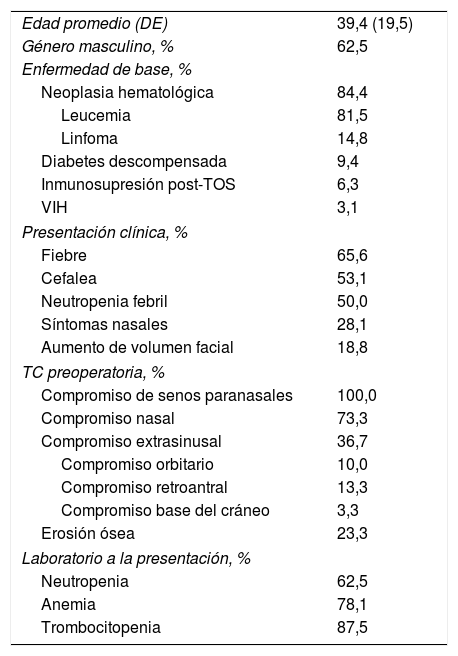La rinosinusitis fúngica invasiva aguda (RSFIA) es una enfermedad poco frecuente, de alta mortalidad. Se presenta principalmente en pacientes inmunocomprometidos con múltiples comorbilidades, lo que dificulta su manejo. El objetivo de este trabajo es describir una cohorte de pacientes operados por RSFIA, sus características clínicas y mortalidad, los agentes etiológicos y el rendimiento de los métodos de diagnóstico.
Material y métodoEstudio prospectivo no concurrente de pacientes operados por RSFIA entre el 2005 y 2015 en nuestro centro.
ResultadosSe incluyeron 32 pacientes, 62,5% (20/32) hombres, con una edad promedio de 39,4 años (16-65 años). La mortalidad global fue del 71,9%, correspondiendo un 46,9% a mortalidad en agudo y un 25% a tardía. Las neoplasias hematológicas fueron la enfermedad de base más frecuente, correspondiendo al 84,4% (27/32) de los casos, seguida de la diabetes mellitus en un 9,4% (3/32). El 62,5% (20/32) de los pacientes presentó neutropenia al diagnóstico, y un 80% (16/20) de ellos, neutropenia febril. El síntoma más frecuente fue la fiebre en un 65,6% (21/32), luego dolor facial o cefalea en un 53,1% (17/32). Se identificó Aspergillus en el 37,5% (12/32), seguido por Rhizopus en el 31,3% (10/32). No se encontró asociación entre las variables estudiadas y un mayor riesgo de mortalidad.
ConclusionesLa RSFIA es una enfermedad agresiva con una alta mortalidad, siendo fundamental el diagnóstico oportuno. Es necesario optimizar los criterios de sospecha para un diagnóstico precoz que permita mejorar el pronóstico.
Acute invasive fungal rhinosinusitis (AIFRS) is rare but has high mortality. It is more frequent in immunocompromised patients with multiple comorbidities, which make their management more difficult. The aim of this study is to describe a cohort of patients operated due to AIFRS, their clinical characteristics, mortality, aetiological agent and efficacy of diagnostic tests.
Material and methodNon-concurrent prospective study of patients with AIFRS who were operated between 2005 and 2015 in our centre.
ResultsThirty-two patients were included, 62.5% (20/32) men, with an average age of 39.4 years (16-65 years). Overall mortality was 71.9%; acute mortality 46.9% and late mortality 25%. Haematological malignancies were the most common underlying disease, present in 84.4% (27/32) of cases, followed by diabetes mellitus in 9.4% (3/32). On diagnosis, 62.5% (20/32) of patients were neutropenic, 80% (16/20) of them with febrile neutropenia. Fever was the most frequent symptom, present in 65.6% (21/32) of patients, followed by facial pain or headache in 53.1% (17/32). Aspergillus was identified in 37.5% (12/32) of cases and Rhizopus in 31.3% (10/32). There was no association between the analysed variables and increased risk of mortality.
ConclusionsAIFRS is an aggressive disease with a high mortality rate, therefore a timely diagnosis is fundamental. It is necessary to optimise suspicion criteria for an early diagnosis in order to improve the prognosis.
Artículo
Comprando el artículo el PDF del mismo podrá ser descargado
Precio 19,34 €
Comprar ahora







